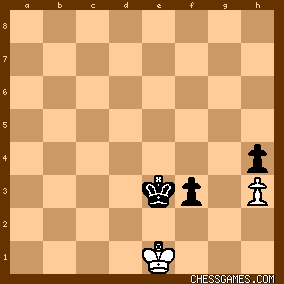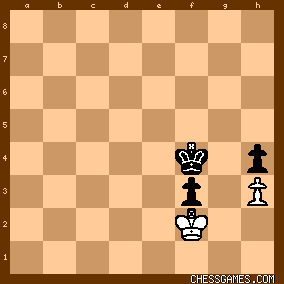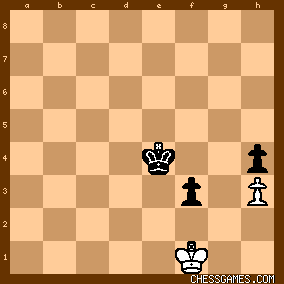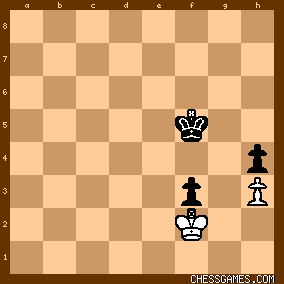|
< Earlier Kibitzing · PAGE 3 OF 5 ·
Later Kibitzing> |
| Jul-08-08 | | ToTheDeath: This is not a flashy game, but it is a very deep and beautiful one nonetheless. Kasparov sacrificed a pawn for piece play and it worked- Alburt had to play very carefully to avoid a disaster- but even making it to a Queen ending didn't help him, with Kasparov's accurate zwischenzug 37...Qb1+!, forcing the Queens off the board and preventing 38.Qd8+. Of course the triangulation at the end to win is also very beautiful and worth studying in depth. One of Kasparov's best games- a gem. |
|
| Jun-02-11 | | DrMAL: seems white's mistake 29.Qg1 could have been further exploited by 31...Qa3 31...Qa3 32.h3 a5 33.Kh2 Qb4
winning white's b-pawn and the game |
|
| Aug-22-12 | | Patriot: This is a triangulation problem.
55...Ke5 56.Ke1 Kf5 57.Kf1 Ke4 58.Ke1 Ke3 wins.
55...Ke5 56.Kg1 Kf5 57.Kf1 Ke4 transposes.
The idea is after 55...Ke5 56.Kf2, black has 56...Kf4 winning. |
|
Aug-22-12
 | | LoveThatJoker: WC Kasparov!!
<55...Kf5! 56. Kg1>
[56. Kf2 Kf4 57. Ke1 (57. Kg1 Ke3 58. Kf1 f2 59. Kg2 Ke2 60. Kh2! Ke1! 61. any f1=Q+!  ) 57...Kg3 (57...Ke3 also wins for Black) 58. Kf1 f2 59. Ke2 Kg2 ) 57...Kg3 (57...Ke3 also wins for Black) 58. Kf1 f2 59. Ke2 Kg2  ] ] <56...Ke5! 57. Kf1>
(57. Kf2 Kf4  ; 57. Kh2 Kf4 58. Kh1 Ke3 59. Kg1 Ke2 ; 57. Kh2 Kf4 58. Kh1 Ke3 59. Kg1 Ke2  ; 57. Kh1 Ke4 58. Kg1 Ke3 59. Kf1 f2 60. Kg2 Ke2 61. Kh2 Ke1! ; 57. Kh1 Ke4 58. Kg1 Ke3 59. Kf1 f2 60. Kg2 Ke2 61. Kh2 Ke1!  ) ) <57...Ke4> 0-1
Black has won the position via triangulation as now it is the exact same position as the start of the puzzle only with White to move. This is bad for White as he is in zugzwang and must surrender the opposition to Black. For example,
A) 58. Kf2 Kf4 
B) 58. Ke1 Kg3 (58...Ke3 also wins for Black) 59. Kf1 f2 60. Ke2 Kg2  C) 58. Kg1 Ke3 59. Kf1 f2 60. Kg2 Ke2 61. Kh2! Ke1!
LTJ |
|
| Aug-22-12 | | Moonwalker: I went For 55. ...Ke5, the idea being to lose a move and get the opposition by way of triangulation. According to a comment from 2004 by <chessgames.com> Ke5 gets the job done just as well as the text. A year ago I would never have got this. Infact I wouldn't have even considered a backwards move by the king! |
|
| Aug-22-12 | | M.Hassan: "Medium/Easy" Black to play 55...?
Black is a pawn up
55.........Ke5
56.Ke1 Kf5
57.Kf1 Ke4
By 21/2 moves, Black arrived at exactly the same puzzle position. The only difference now is that it is White's move: 58.Kf2 Kf4
59.Kf1 Kg3
60Kg1 Kxh3
Black has now two pawns and his win is definite. Let us see when White resigned |
|
| Aug-22-12 | | Abdel Irada: <Give me your coordinates> With the paucity of pawns, this position offers a fairly simple example of coordinate square theory: Each king seeks to move to a given square in response to the other reaching a corresponding square, leaving the other in zugzwang. Most of us are familiar with this idea in its simplest form: the opposition, when whoever gives ground first must abandon hope. Here Black wins by triangulation, moving so as to return to the initial position — this time with White to move: 55. ...♔f5!
Note: ...♔e5! also wins by transposition.
56. ♔e1/♔g1
If 56. ♔f2?, ♔f4  . .
56. ...♔e5;
57. ♔f1, ♔e4!
Now we see the point of Black's maneuver. White must move, and has three choices: (1) 58. ♔f2, ♔f4 (the opposition);
59. ♔f1, ♔g3;
60. ♔g1, ♔xh3 
With two pawns, Black can easily find a tempo to dislodge the white king from a queening square. (2) 58. ♔e1, ♔e3 (the opposition);
59. ♔f1; f2!;
60. ♔g2 ▢, ♔e2 
White can't stop the pawn queening.
(3) 58. ♔g1, ♔e3 and White can pick his poison:
(3.1) 59. ♔f1, f2;
60. ♔g2 ▢, ♔e2  as in variation (2). as in variation (2).
(3.2) 59. ♔h2/♔h1, f2;
60. ♔g2, ♔e2;
61. ♔h2 (White's last hurrah, hoping for stalemate), ♔e1!  Now Black will queen with check and mate shortly thereafter. |
|
| Aug-22-12 | | sevenseaman: I think 55...Kf5 (or Ke5) should do the trick. Idea is to discomfit the White K. Without laying any claim to the shortest line, I think this is what would happen. 55...Kf5 56. Kg1 Ke5 57. kg1 Ke3 58. Kf1 f2 59. Kg2▢ Ke2 a) 60. Kh1 f1=Q+ 61. Kh2 Qf4+ 62. Kg2 Qg5+ 63. Kh1 Kf3 64. Kh1 Qg2# b) 60. Kh2 f2 61. Kg2 Ke2 62. Kh2 Kf3 63. Kh1 f1=Q+ 64. Kh2 Qg2# |
|
| Aug-22-12 | | Abdel Irada: <sevenseaman>: There appear to be some typos in your analysis. For example, on moves 56-57, you have White's king moving from g1 to g1 (which would rather defeat the entire idea of zugzwang) and Black's from e5 to e3. |
|
| Aug-22-12 | | sevenseaman: <Abdel Irada> thanks for checking. There are typos. Normally I do check back but today a rare listlessness seeped through. I will try and rewrite. |
|
| Aug-22-12 | | sevenseaman: Thanks to <Abdel Irada> pointing out a number of typos I have rewritten part of my solution. 55...Kf5 56. Kg1 Ke5 57. Kf1 Ke4 58. Kg1 Ke3 59. Kf1 f2 60. Kg2 Ke2 60. Kh1 f1=Q+ 61. Kh2 Qf4+ 62. Kh1 Kf3 63. Kg1 Qg3+ 64. Kh1 Qg2# (or 64. Kf1 Qf2#). |
|
| Aug-22-12 | | whiteshark: As a certificated Master Mariner I know what triagulation means. :D |
|
| Aug-22-12 | | White Star: Two words: distant opposition |
|
| Aug-22-12 | | Tiggler: Enjoyable part about this endgame is the part played by the h pawns. They look dead, but without them Black cannot win. |
|
| Aug-22-12 | | SamAtoms1980: Hmm, this would be easier with White to move. That can be arranged with a triangulation: Ke4-e5-f5-e4 (or the other way around) and wins. |
|
| Aug-22-12 | | Once: It's easy when you know the theory, but witchcraft if you don't. The first key position is this one:

click for larger viewIf we arrive at this position, the outcome of the game will depend on who is to move. And it turns out that you want the other guy to be the one about to move. If it's white to move, his king has to give way and the black pawn crashes through ... Ke1/f2 or Kg1/f2. The pawn arrives safely on the seventh rank without giving check, which usually means game over. If it's black to move, he can't make progress. He doesn't want to play 1...f2+ because 2. Kf1 either steals the pawn or forces 2...Kf3 stalemate. By the same logic, another key position is this one:

click for larger viewIf it's black to move, his king has to retreat. That means he is no closer to queening a prawn. On the other hand, if it's white to play, he has to retreat. This allows black to push on with Ke3 or Kg3 and then the f-prawn will queen. So rewind a move each and we get to our puzzle position: 
click for larger viewThe first thing to note is that the immediate 55...Ke3 doesn't work. After 56. Ke1 we are into our first key position, but with black to move. And as we've seen, that doesn't work. Nor can black play 55...Kf4 straight away. Then white replies 56. Kf2 and we are into our second key position and again its black to move. This means that our puzzle is another of those positions where you don't want to be on the move. But it only works for white if we land on exactly this position with black to move. In other words, if the black king is on e4 (threatening Ke3), the white king must be on f1 (to answer Ke3 with Ke1). The trick here is that white has a lot less space than black. His king is on the back rank, which means that he only has one rank to work with. By contrast, the black king has several ranks to work with. This means that white can get to and from f1 in exactly two moves (Kf1/Ke1/Kf1) or (Kf1/Kg1/Kf1), but he can't get from f1 and back again in three moves. By contrast, black can get to e4 in either two or three moves. The three move quickstep is a little triangle of (Ke4-Kf5-Ke5-Ke4) or the equally good (Ke4-Ke5-Kf5-Ke4). In other words, by taking three moves to white's two, black can recreate the puzzle position, but with white to move instead of black. And that means that he can force either of the two key positions with white to move. Aha! I hear you cry. White does have two ranks to play with. He can triangulate himself by playing Kf2 at some point. So what if we get something like... 55...Kf5 56. Kf2 
click for larger viewThat does indeed cut across black's fancy stepping on f5 and e5. And if 56...Ke4 57. Kf1 repeats the position. But black simply reverts to key position two with 56...Kf4 and wins. So the winning strategy from the POTD start is ... recreate the starting position but with white to move by taking three moves to get back to it (via e5 and f5 in either order). And if white tries Kf2 at any time, jump into Kf4. |
|
| Aug-22-12 | | Abulherar: Wednesday Puzzle:Medium/Easy
Black To Play:55...
The Solution is:55...Kf5!
(NOT:55...Ke3 56.Ke1 or 55...Kf4 56.Kf2)
56.Kg1 (or:56.Ke1)
If:56.Kf2 Kf4! (Black Wins)
56...Ke5!! (White Resigns)
Because:57.Kf1 Ke4 58.Ke1 Ke3
59.Kf1 f2 60.Kg2 Ke2 61.Kh2 f1=R
If:61...f1=Q (Stalemate=Draw)
62.Kg2 Rf2+ 63.Kg1 Ke3
64.Kh1 Kf3 65.Kg1 Kg3
66.Kh1 Rf1#
NICE Triangulation Problem!!! |
|
Aug-22-12
 | | FSR: I had seen this game at some point, knew that Black had won, and was pretty sure that 55...Kf5 was the move. Nonetheless, I am a bit embarrassed to say, I had a hard time finding the win. Finally it dawned on me that White is in zugzwang in the diagram position, so Black just has to transfer the move to White. 55...Kf5! 56.Kg1 (56.Kf2? Kf4 and 57...Kg3; 56.Ke1 Ke5! is similar to the main line) Ke5! 57.Kf1 Ke4! 58.Ke1 (58.Kg1 Ke3) Ke3 etc. |
|
| Aug-22-12 | | morfishine: <55...f5> was my selection to gain the opposition and achieve a winning position. I'd be curious to see if its as effective as <55...e5> or if there is some deep, hidden flaw. Its funny, in the opening and middlegame, one doesn't dare surrender a tempo; However, in the ending, there are situations where we can't give'm away fast enough! (in order to win) |
|
| Aug-22-12 | | poszvald: 55, ..Kf5
56, Kg1 Ke5
57, Kf1 Ke4 same position but white to move
58, Ke1 Ke3
59, Kf1 f2
60, Kg2 Ke2
61, Kh2 Ke1
62, Kh1 Qf1+  |
|
| Aug-22-12 | | Memethecat: An essential bit of endgame technique that everyone should know or learn, I call it triangulation, but there might be another name. If it was whites move black could easily march straight over & capture the white pawn or shepered his own pawn home. Black can create that situation by moving his K in a small 3 move triangle e5>f5>e4 or f5>e5>e4, white is now in Zugzwang, any move loses. (if after moving to the 5th rank white plays Kf2, then Kf4 wins even quicker) Most of the people on here will know this trick, but if you don't, learn it! its the difference between a draw & a win. |
|
| Aug-22-12 | | Memethecat: <Once> has done a good job of explaining it, but if anyone's still having trouble visualizing it, then setting up the position in the nalimov table & seeing all the different ways it can be played might help: http://www.thechessworld.com/resour... |
|
| Aug-22-12 | | kelu: G. Kasparov is good in endings. But I hope he won't have the same end then the Pussy Riot... Someone know a way to help him ? |
|
| Aug-22-12 | | Herma48852: I blew it and didn't realize that sacking the pawn with 55 .. f2 and then taking the opposition would lead to a stale mate due to the rook pawn. |
|
| Aug-22-12 | | EXIDE: This is too difficult for a Tuesday puzzle. Anyway thanks to <Once> I am getting an inkling of the process needed to win. |
|
 |
 |
|
< Earlier Kibitzing · PAGE 3 OF 5 ·
Later Kibitzing> |





